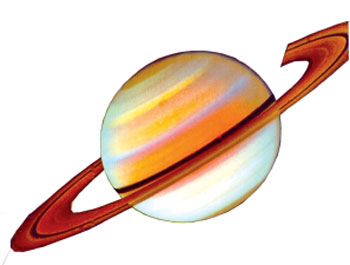Saturn - Second largest planet

Saturn is a gas giant made up mostly of hydrogen and helium. Saturn
is the second largest planet, big enough to hold more than 760 Earths,
and is more massive than any other planet except Jupiter, roughly 95
times Earth's mass. However, Saturn has the lowest density of all the
planets, and is the only one less dense than water if there were a
bathtub big enough to hold it, Saturn would float on top.
Although the other gas giants in the solar system - Jupiter, Uranus
and Neptune have rings, those of Saturn are without a doubt the most
extraordinary. The largest one to date spans up to 200 times the
diameter of the planet.
Saturn is the farthest planet from Earth visible to the naked human
eye. The yellow and gold bands seen in the planet's atmosphere are the
result of super-fast winds in the upper atmosphere, which can reach up
to 1,100 miles per hour (1,800 kilometres per hour) around its equator,
combined with heat rising from the planet's interior.
Saturn spins faster than any other planet except Jupiter, completing
a rotation roughly every 10-and-a-half hours. This rapid spinning causes
Saturn to bulge at its equator and flatten at its poles. The planet is
8,000 miles (13,000 kilometres) wider at its equator than between the
poles.
Saturn's most recent curiosity may be the giant hexagon circling its
north pole, with each of its sides nearly 7,500 miles (12,500 kilometres)
across and big enough to fit nearly four Earths inside.
Thermal images show it reaches some 60 miles (100 kilometres) down
into the planet's atmosphere. It remains uncertain what causes it. In
Roman mythology, Saturn is the god of agriculture. The associated Greek
god, Cronus, was the son of Uranus and Gaia and the father of Zeus
(Jupiter). Saturn is the root of the English word "Saturday".
Saturn has been known since prehistoric times. Galileo was the first
to observe it with a telescope in 1610; he noted its odd appearance but
was confused by it. Early observations of Saturn were complicated by the
fact that the Earth passes through the plane of Saturn's rings every few
years as Saturn moves in its orbit. A low resolution image of Saturn
therefore changes drastically.
It was not until 1659 that Christiaan Huygens correctly inferred the
geometry of the rings. Saturn's rings remained unique in the known solar
system until 1977 when very faint rings were discovered around Uranus
(and shortly thereafter around Jupiter and Neptune). Saturn is the least
dense of the planets; its specific gravity (0.7) is less than that of
water. |


